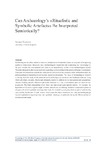Can Archaeology's "Ritualistic and Symbolic Artefacts" be interpreted semiotically?

View/
Use this link to cite
http://hdl.handle.net/2183/13396Collections
Metadata
Show full item recordTitle
Can Archaeology's "Ritualistic and Symbolic Artefacts" be interpreted semiotically?Author(s)
Date
2012Citation
Culture of communication / Communication of culture, 2012: 89-100. ISBN: 978-84-9749-522-6
Abstract
[Abstract] Archaeologists are often content to leave an interpretation of material culture at the point of recognising symbolic behaviours. However, new archaeological researches are expanding our knowledge of the past towards the non-material and what is not immediately visible in the archaeological record. Phenomenological studies in particular are expanding our knowledge to the perceived human environment. Computer reconstructions expand the architectural and artificial environment while archaeobotanical and archaeozoological researches reveal ancient natural environments. The focus of archaeological research is moving from the study of the materials retrieved during excavations to past landscapes that are being filled with plants, animals, objects and ultimately people in addition to the monuments and geographical features. Linking specific objects to particular functions is a way to reconstruct past activities as well as gestures. The final consumption of an object can also reveal quite specific actions. For instance, the deposition of objects in a grave might be better defined than an offering. Artefacts connected to power or religion will embed symbolic meanings that might be revealed by analysing them as part of semiotically interpretable behaviours. I shall present some examples where semiotics can help archaeologists go beyond explanations regarding ritual and symbolic meanings, in particular taking the Minoan palace of Knossos as case-study.
ISBN
978-84-9749-522-6





